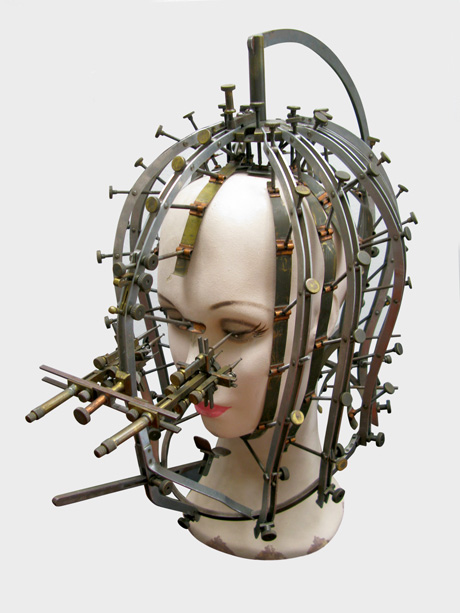by SASHA ARCHIBALD
 The Beauty Calibrator invented by Max Factor in 1932. The device, which measured the degree to which a person’s face and head differed from what was deemed to be ideal, was used to determine the most effective makeup solution.
The Beauty Calibrator invented by Max Factor in 1932. The device, which measured the degree to which a person’s face and head differed from what was deemed to be ideal, was used to determine the most effective makeup solution.
Cinema tends to make beautiful people look more beautiful, but it wasn’t always so. In its earliest days, film had an adversarial relationship to beauty, exaggerating the tonal and textural variations of the human face so that even the most stunning heroine became a blotchy caricature. Early black-and-white film stocks—first, orthochromatic film, dominant until 1927, and to a lesser degree its successor, panchromatic film—rendered dark colors darker and light colors lighter, turning features that seemed innocuous off camera (rouged cheeks, a constellation of moles) into distracting blemishes when seen on the screen. Pimples and freckles looked like spots of mud and blue eyes seemed colorless; lipstick made the mouth a cavernous hole and a complexion with sallow or pink undertones appeared, in the term of the time, “negroid.” Techniques borrowed from the stage also proved problematic: face paint used to suggest wrinkles to a theater audience, for example, read as tattoos on film. Cinematic makeup, then, was not born from vanity—it was a necessary antidote to the flawed medium of film.
…
For problems that could be solved with wigs rather than haircuts, Factor devised a rental system that made high-quality, realistic hairpieces affordable to producers. Indeed, Factor’s hairpieces, painstakingly crafted using human hair, were far preferable to those used on early film sets: wigs made of mattress stuffing, and stubble made of tobacco flakes. It was said that Factor was such a hair connoisseur that he could identify hair that had never been dyed or artificially curled by smell alone. Insisting that his wigs be made only of such “virgin” hair, he sourced most of his supply abroad and paid a premium for silky red or white hair. Through his salon’s back door, Factor discreetly fitted stars—among them Fred Astaire, George Burns, John Wayne, James Stewart, and Frank Sinatra—for toupees, and invented a scalp prosthetic so that actors could play a bald-headed man in one scene and display a full head of hair in the next. Factor’s studio also designed and fitted underwear for chimpanzee actors in the popular Tarzan films—the Production Code demanded that the apes’ genitalia be camouflaged—and at the peak of its fame, in 1938, it crafted 903 elaborate white wigs for Marie Antoinette (directed by W. S. Van Dyke).
…
Mainstream audiences, however, lived off camera, where they were occasionally chastised for donning lipstick or powder, and some were even fired for wearing the stuff at work. Makeup carried the lingering taint of prostitution through the 1920s, to the degree that a police officer might demand a woman go wash her face. Cosmetics were better tolerated when they were inconspicuous—women’s magazines and media pundits alike begged women to apply their makeup with a subtle hand, and to please, please, not put it on in public. Natural-looking makeup was the gateway to social acceptability, the compromise position between women who were inexorably drawn to the possibility of dramatically altering their appearance and men who bemoaned the loss of “sweet, clean” kisses.1 Curiously, cinema was pushing in exactly the same direction. In 1918, an actress would cake her face with greasepaint and lift the angle of her nose with silk thread, but by 1935, such obvious artifice was unthinkable. As the magnifying powers of the camera increased and Technicolor film made its debut, the standard for screen makeup became invisibility. The zenith of Factor’s career was his invention of a product that simultaneously met the market demand for an innocuous, subtle makeup and the film industry’s need for a substance that beautified while looking convincingly natural.
Cabinet for more
